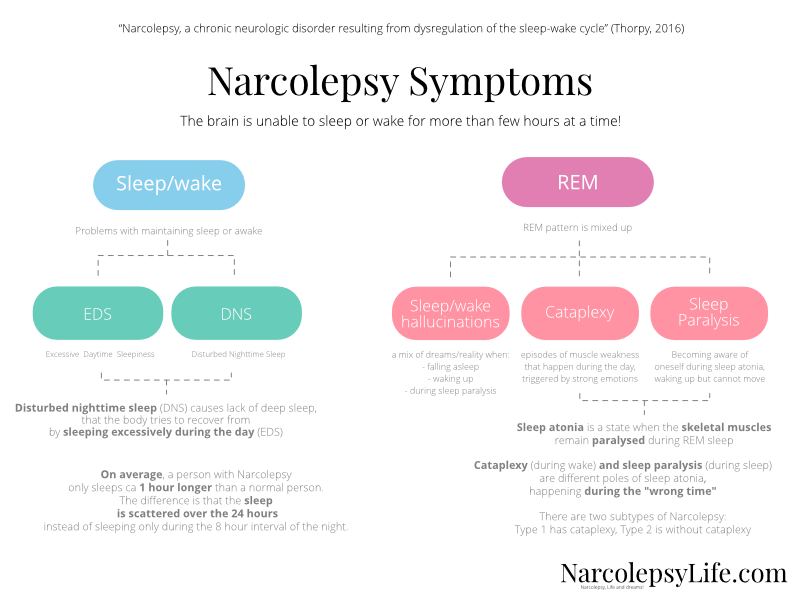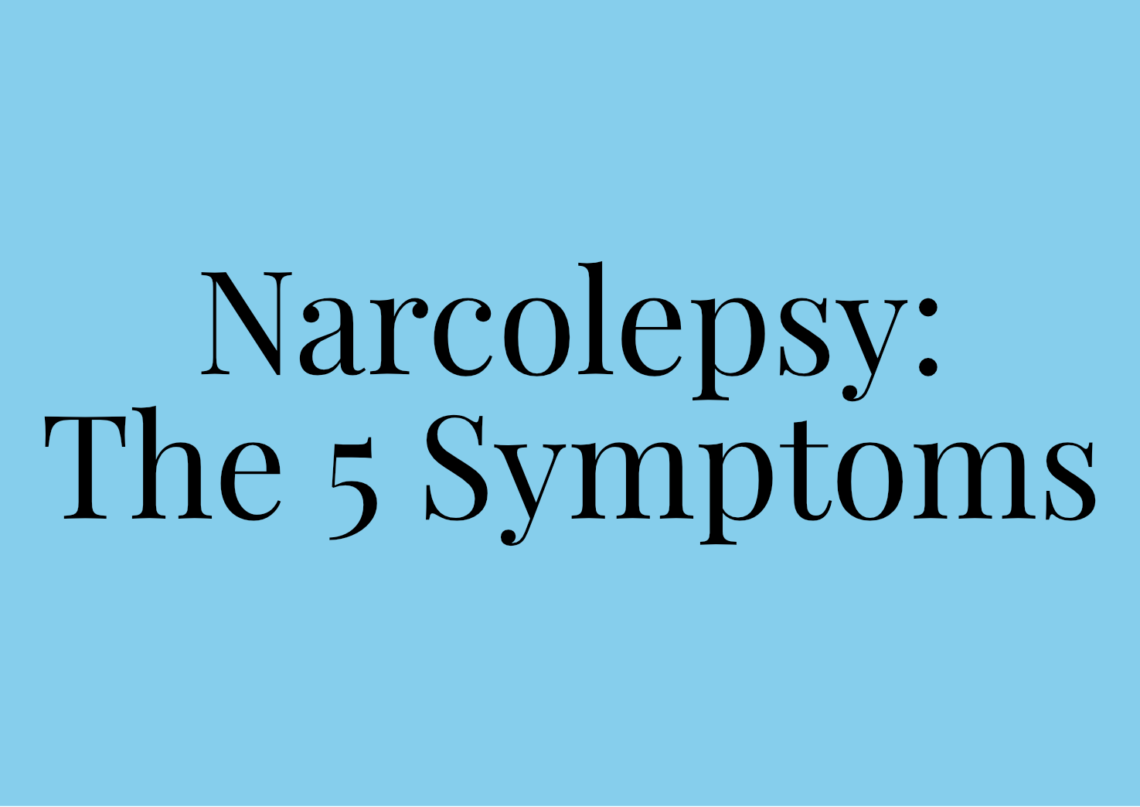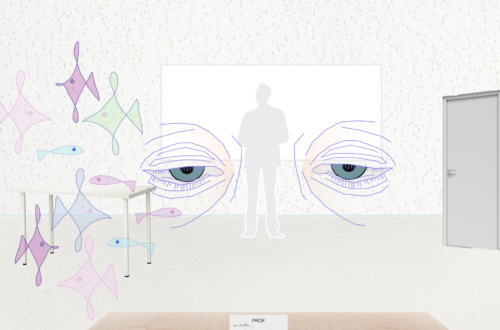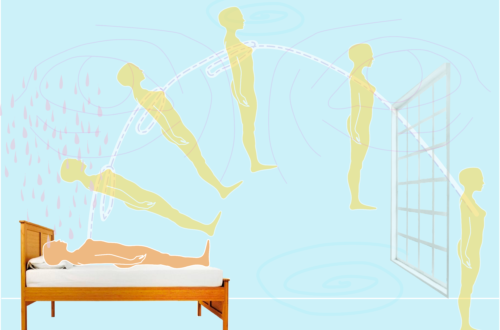“Narcolepsy, a chronic neurologic disorder resulting from dysregulation of the sleep-wake cycle”
(Thorpy, 2016)
Thorpy’s quote says it all.
Narcolepsy is a sleep problem, where the body cannot maintain sleep or awake for more than a few hours at a time. The reason is lack of brain chemical called orexin/hypocretin, whose purpose is, among other things, to promote wakefulness, but has also been linked to appetite. Having low levels of this particular chemical does not only make one sleepy but creates many other sleep-related problems. (Mieda & Sakurai, 2016).
The problem is, this description does not really give any idea of how the symptoms can manifest and how it feels. Here is my perspective
The symptoms: two categories
Narcolepsy has five defined symptoms: Excessive daytime sleep (EDS), disrupted nighttime sleep (DNS), Cataplexy, hypnagogic hallucinations and sleep paralysis.
To simplify, we can put these five symptoms into two categories:
- The sleep/wake problem
- REM pattern mixed-up

The Sleep/wake problem
Symptom: Excessive daytime sleepiness -EDS
AND
Symptom: Disturbed nighttime sleep – DNS
Narcolepsy = sleep deprivation
As strange as it sounds, people with Narcolepsy do not really sleep more than healthy people. What is really happening is that narcoleptics keep waking up during the night and never experience a healthy amount of deep and restorative sleep as healthy people do.
People with Narcolepsy have low levels of brain chemicals called orexin/hypocretin that promote wakefulness. Without this chemical, the sleep/wake pattern is dysregulated which makes it impossible to sleep for a full night or remain awake for a full day.
In other words: because of Disturbed nighttime sleep (DNS) and therefore lack of deep sleep, the body tries to recover from sleep deprivation by sleeping excessively during the day (EDS)
It is said that a normal person needs to stay awake for 48-72 hours to feel as sleepy as a Narcoleptic person feels every day (Flygare & Parthasarathy, 2015). Common suggestions like drinking a cup of coffee going to be earlier will not help.
Interesting fact: children with Narcolepsy have too often been misdiagnosed with ADHD. Not staying still is usually a sign of ADHD, but in the case of Narcolepsy, not being still is a coping method for excessive daytime sleepiness! (Lindsley, 2016)
How it feels – EDS
I usually feel when I am getting tired, I do not just suddenly fall asleep like portrayed in many movies. I start yawning, I feel tingling in my eyelids and cannot keep my eyes open. My cognitive mind becomes foggy, I feel the simplest tasks become incredibly complicated and I cannot have a conversation because, somehow, I cannot think. When I feel this, it is time to take a nap. If I do not take a nap, I will eventually sleep anyway. Wherever I am, sitting or standing, I might close my eyes and have a microsleep, or repeated microsleeps, until I feel my attention has kicked back in. I might nap on the sofa, in a comfortable chair or laying on a bench for a better nap. In a few minutes, I wake up again and feel refreshed, or I wake up and do not feel refreshed, then I have to sleep a little longer. I dream during these microsleeps or naps. Sometimes I become stuck in a loop of dream-hallucinations during the end of my nap, that prolongs the nap, but it does not make me feel refreshed. The tricky part is to break the loop and wake up because sometimes, I think I am up, when I am still in a dream/hallucination state.
How it feels – DNS
I always wake up after circa two hours of going to bed. During these first two hours, I usually get a good relaxing sleep. After the two hours, I wake up repeatedly and dream very vivid dreams, and do not feel rested when I wake up in the morning. When I feel I cannot sleep, it helps to do something for ca 30-60 minutes, and then go back to sleep. I sleep better after a short time of being awake than if I stay in bed trying to sleep.
In-depth: The disruption of the sleep cycle explained
- Every night consists of ca 4-5 sleep/wake cycles.
- Each cycle consists of circa 90-minute loop going through the sleep stages back and forth.
The hypnogram below shows a comparison of what is considered a normal pattern VS a pattern of a person with Narcolepsy.

- The normal person, went to sleep at circa 23 and woke up at 7, and during the night, there were five regular deep sleep “dives” through the night, and between each dive, a top where the person went to REM sleep, or dream sleep.
- The narcoleptic person also went to sleep at 23 and woke up at 7, but the sleep is scattered over the 24 hours. The individual is waking up multiple times during the night, getting limited deep sleep, showing an abnormal pattern of REM sleep and multiple periods of daytime sleep.
The REM pattern mix-up
Explaining the REM-related problems can be tricky, but let’s give it a try:
- REM stands for Rapid Eye Movement and is the stage of the sleep cycle, in which we dream.
- Muscle atonia is something that naturally happens during REM sleep, and is a state where the skeletal muscles are paralysed so we cannot move.
This brings us to the REM-related symptoms of Narcolepsy.
Symptom: Sleep Paralysis
Sleep paralysis is when we become conscious enough to be aware of ourselves, but we cannot move because of the muscle atonia. Everybody can experience sleep paralysis, but because of the REM dysregulation of people with Narcolepsy, they experience this frequently.
Symptom: Cataplexy
Cataplexy is very interesting and at the same time, not much fun to deal with. Cataplexy is sort of Sleep Paralysis, a muscle weakness that happens during awake time and is triggered by strong emotions. Laughter is the most common trigger for Cataplexy attacks, but not the only one.
Research shows that Cataplexy is usually triggered by positive emotions, like laughter and pleasant surprise, and less likely with negative emotions such as rage or danger (Reading, 2019).
Cataplexy can be everything between mild, where a person feels weakness in the facial muscles and neck, up to a strong attack where a person collapses to the ground and has no control. As a result of this uncontrollable muscle weakness, people with Cataplexy tend to suppress emotions and do not express them freely, which is obviously not good for anybody. People can develop anxiety, start to avoid social situations that are potential triggers and become socially isolated.
Not all people with Narcolepsy experience cataplexy. Narcolepsy two subtypes: Type 1 has Cataplexy, Narcolepsy 2 is without Cataplexy.
How it feels – Cataplexy
For me, Cataplexy is mostly triggered by laughter and surprise. This has to be something that hits my particular humour or a surprise. Usually, I feel the muscle weakness in my cheeks, jaw, neck, arm and hands. People typically do not notice it, but as an example, when holding a glass in my hand, the whole arm might limp a little. When I have a stronger attack, I collapse. Especially when I am the one telling the punchline of a joke, I cannot hold my head up straight, or speak clearly, I need to sit down on a chair to lean on the table or find another safe place. Then I continue, trembling and finishing my joke. If I do not find a safe place, I collapse, and hopefully, I will not get injured by the fall.
Interesting fact: What do Cataplexy and sleep paralysis have in common?
Cataplexy (during wake) and sleep paralysis (during sleep) are basically both sleep atonia, but the opposite poles, happening during the “wrong time”.
Symptom: Hypnagogic hallucinations
Hypnagogic hallucinations come while falling asleep or waking up. These are dreamlike experiences that are very real and intrude our wakefulness.
How it feels – Hypnagogic hallucinations
Many times, while I nap in my bed, I hear people in my living room talk. Sometimes, I feel the bed shake when someone comes crawling in my bed, but do not know who it is. Sometimes, I think I am awake, and I go do things, like eat breakfast and brush my teeth, but then wake up to learn that everything was just a “dream”. I have many times had a conversation with a family member, and then started having REM intrusions and kept answering them in my dream. And even more strangely, sometimes, I hear people in other places of the world, have a conversation, or I can tap into the radio frequencies and listen to the music……
Conclusion
While Narcolepsy itself is a big problem, not being able to get a good rest creates all sorts of secondary problems and symptoms. We all need deep sleep to rest and restore our body. Lack of sleep negatively affects our cognitive abilities, along with our bodily functions (Brand & Kirov, 2011).
Think about it. Today, there is a lot of pressure from all directions of society that makes life with Narcolepsy very challenging:
- To wake up for work after a night of mostly dreams and hallucinations,
- To be on time anywhere you go when you suddenly need a nap that you cannot skip,
- To not fall asleep during lessons or at meetings and risk making a bad impression,
- To go to all the football practices or school plays of your children and not sleep all the time, cook and clean…..
- And in between, finding time to spend with the family and maybe a little alone time with your partner.
- In addition, for those with Cataplexy, to risk possibly collapsing in a party, at work, on the street…….
On top of that, some people can be very judgemental and think sleep is wasting time, and expect the narcoleptic to do better.
All this. Everyday. Without ever getting a good night sleep.
It can make a narcoleptic a little grumpy and less tolerant of problems. Overall, most narcoleptics are just long term tired of dealing with all the pressure every day.
This pressure causes these secondary problems such as depression and anxiety.
My 8 tips on how to live with Narcolepsy
1. I know my symptoms. What triggers what symptoms, what helps reducing symptoms, and how to deal with situations that come up.
2. I know my limits, and I keep within my limits as much as I can (not always possible!) If I need a nap, I nap.
3. When I exceed my limits, I know what to expect and work with it. Sometimes it means the next day I have no energy.
4. Support from my parents and my husband makes life a million times easier. He knows that I need my naps and that if I do not nap, I do not function.
5. The rest of my family knows I have Narcolepsy, and they know that when I disappear at family dinner, I am having a nap.
6. For others, I explain if I feel I need to.
7. I do not let other peoples idea of how I should live my life, affect me. I know better than they do what is best for me.
8. I never expect people to completely understand how I feel.
Reference:
– Brand, S., & Kirov, R. (2011). Sleep and its importance in adolescence and in common adolescent somatic and psychiatric conditions. International Journal of General Medicine, 4(2011), 425–442. doi: 10.2147/IJGM.S11557
– Flygare, J., & Parthasarathy, S. (2015). Narcolepsy: Let the Patient’s Voice Awaken Us! The American journal of medicine, 128(1), 10–13. doi: 10.1016/j.amjmed.2014.05.037
– Lindsley, G. (2016). Narcolepsy, Intimacy, and Sexuality. Í NarcolepsyâA Clinical Guide (bls. 217–231). doi: 10.1007/978-3-319-23739-8_15
– Mieda, M., & Sakurai, T. (2016). Orexin (Hypocretin) and Narcolepsy. Í Narcolepsy – A Clinical Guide (bls. 11–23). doi: 10.1007/978-3-319-23739-8_2
– Reading, P. (2019). Cataplexy. Practical Neurology, 19(1), 21. doi: 10.1136/practneurol-2018-002001
– Rogers, A. E., Aldrich, M. S., & Caruso, C. C. (1994). Patterns of Sleep and Wakefulness in Treated Narcoleptic Subjects. Sleep, 17(7), 590–597. doi: 10.1093/sleep/17.7.590
– Thorpy, M. (2016). Diagnostic Criteria and Delay in Diagnosis of Narcolepsy. Í Narcolepsy – A Clinical Guide (bls. 45–49). doi: 10.1007/978-3-319-23739-8_5


